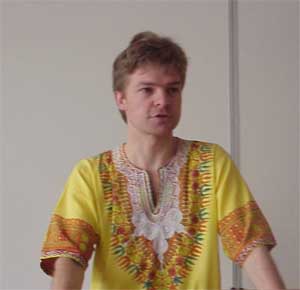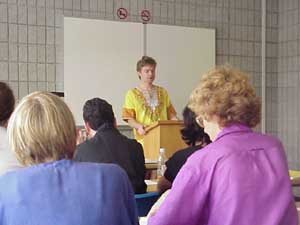|
|
Wylie and Helene Parliament of the World's Religions |
|
Earth Spirit of Africa
Presented by Wayne Visser
When the white colonists came to Africa, they found a land teeming with wild animals. Today many of these species have become extinct, and many others are threatened with extinction.
Wayne Visser looks at the myths and traditions and rituals which, for centuries before whites came to the continent, have sustained the ecological balance of Southern Africa, have caused the soil to be fertile and the wildlife abundant. He explains how many rules and taboos governed hunting among different African tribes. It was forbidden to hunt in the mating season; it was forbidden to hunt a pregnant buck; the Shangani tribe, for example, forbade all hunting unless permission was granted by the king; and certain other tribes set aside sacred areas where hunting was forbidden. Hunters were not allowed to bring back more than they could carry, and to leave carcasses in the field was considered extremely bad luck.
In addition, it was customary for each tribe to adopt a totem in the form of an animal or tree. The tribe would then protect such a totem animal and its associated animals. The Dube tribe, for instance, had the zebra as totem. Not only did they protect zebra herds, but also wildebeest, which were known to co-exist with zebra, as well as the lion, the zebra’s natural enemy, because the lion would weed out the weaker of the species.
Similar "conservation" methods existed with regard to plants and crops. Traditional healers were not allowed to harvest so much bark from a tree that it would destroy the tree. When crops were planted, rituals were performed to bless the crops, and a sacred corn field would often be planted for birds, far from ordinary corn fields and unfenced. Visser relates how "circles of the gods" have been appearing in corn fields in Africa for hundreds of years. The appearance of such a circle would be cause for celebration and fences would be erected around the circles.
Reverence for nature is very strongly embodied in the African creation myth which describes the mother goddess as giving birth to the human race, and all the animals as springing from the branches of a huge tree. Visser argues that indigenous peoples believed that wildlife was the soul of the land. According to Pinda Moleli the first sign of the end of the world would be the disappearance of large herds from the earth.
Visser readily admits that there might be a degree of romanticisation involved in relating indigenous people’s relationship with the land, but he emphasizes that it is not the historical accuracy but the attitude toward nature revealed in the stories that is important. A wise African saying goes: "He who buries the tree, will bury the wild animal, and next his own ox, and ultimately his own children."
Report by Janneke Engelbrecht
|


